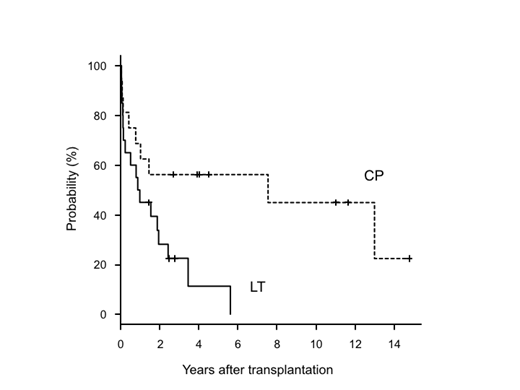INTRODUCTION: Allogeneic hematopoietic cell transplantation provides an opportunity for a cure of myeloproliferative neoplasms (MPNs). Although several studies showed its efficacy even for leukemic transformation (LT) from MPNs, no direct evidence exists which compared the long-term outcome of patients in chronic phase (CP) and LT in a same cohort. METHODS: We retrospectively studied allogeneic hematopoietic cell transplantation for MPNs between 1999 and 2017 in Toranomon Hospital. LT was defined according to the WHO classification in 2016. Risk stratification was according to the dynamic international prognostic scoring system (DIPSS). The spleen index was defined as the measurement of spleen on CT scan. The day of neutrophil and platelet engraftment was defined as the first 3 consecutive days on which the patient's absolute neutrophil and platelet count was >0.5 x 109/L and >20 x 109/L without platelet transfusion, respectively. The study was approved by the ethics committee of Toranomon Hospital (research number #1796), and conducted in accordance with the Declaration of Helsinki. RESULTS: A total of 36 patients were extracted. At transplantation, the disease status of MPN was CP in 16 patients (44%) and LT in 20 (56%). Median spleen index was significantly lower in LT than CP (104 cm2 vs. 150 cm2, p < 0.01), and more CP patients received splenic irradiation before transplantation (p = 0.04). At the start of conditioning regimen, a half of the patients in LT was not in remission even after chemotherapy. Most patients in CP used bone marrow or peripheral blood stem cells, whereas umbilical cord blood (U-CB) was preferred for patients in LT (p < 0.001). Among these 2 cohorts, the cumulative incidence of neutrophil and platelet engraftment was comparable at day 60 and at 1 year after transplantation, respectively (neutrophil engraftment: 87.5% in CP vs. 80.0% in LT, p = 0.11; platelet engraftment: 68.8% in CP vs. 65.0% in LT, p = 0.70). Overall survival (OS) was significantly superior for patients in CP to ones in LT (p = 0.02) (Figure). OS rate at 5 and 10 years after transplantation for patients in CP and LT were 56.2% (95% confidence interval [CI], 1.0 - 35.4) vs. 11.2% (95% CI, 29.5 - 76.2), and 45.0% (95% CI, 17.8 - 69.1) vs. 0%, respectively. Median survival was 7.5 and 0.9 years for patients in CP and LT, respectively. Median follow up of survivors in CP and LT was 1652 days (range, 980 - 5395) and 906 days (range, 522 - 1014), respectively. At 10 years after transplantation, the cumulative incidence of relapse was significantly higher for patients in LT than ones in CP (6.2% in CP vs. 38.0% in LT, p = 0.04). In LT patients, disease recurrence occurred within 3 years after transplantation and 7 out of 17 patients (41%) died of relapse after transplantation. CONCLUSION: To achieve a long-term relapse-free survival, it is crucial for MPN patients to undergo transplantation in chronic phase, not after the development of LT. Delayed decision to transplant may be critical for patients who are at high risk for LT.
No relevant conflicts of interest to declare.
Author notes
Asterisk with author names denotes non-ASH members.


This feature is available to Subscribers Only
Sign In or Create an Account Close Modal